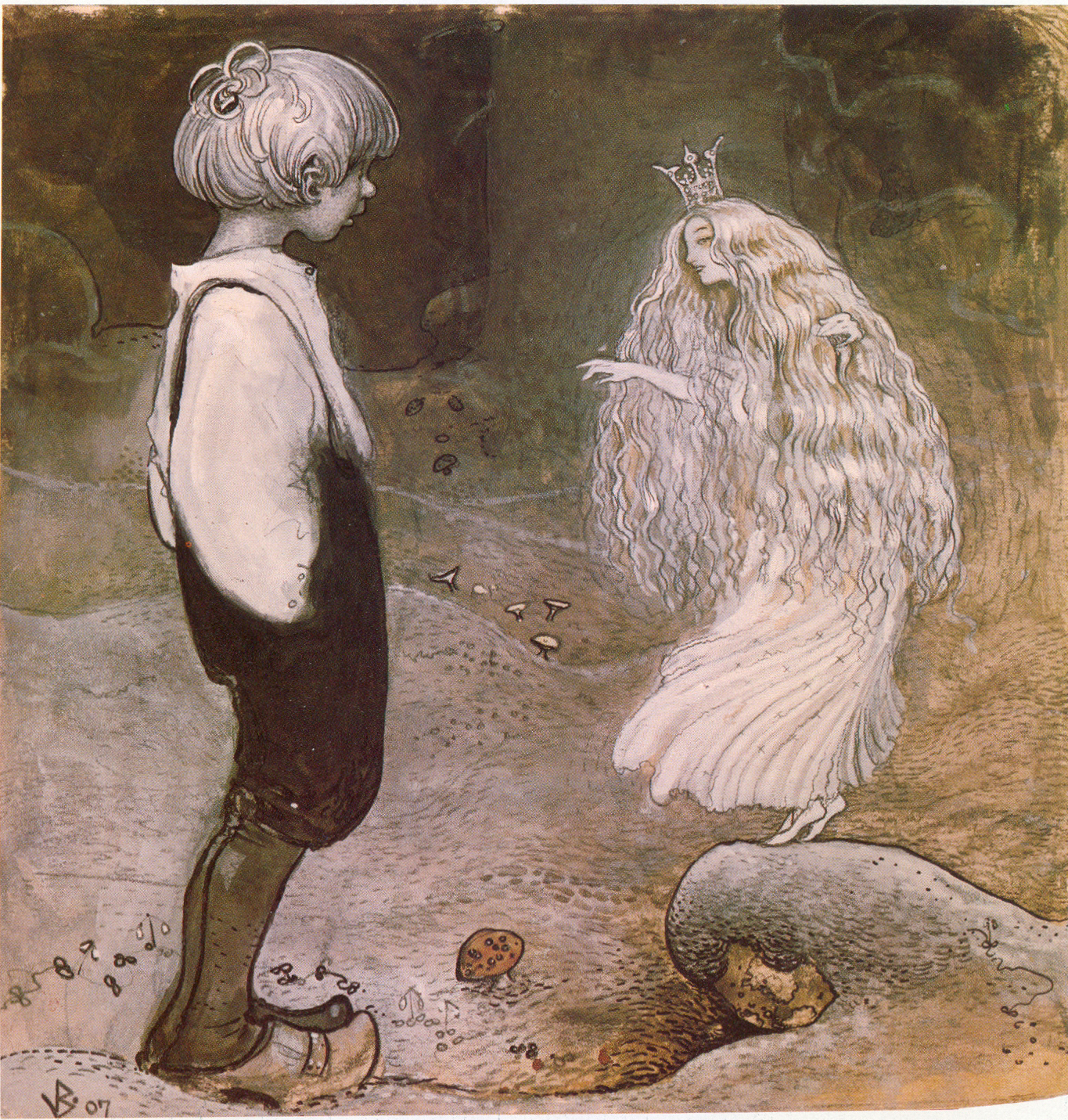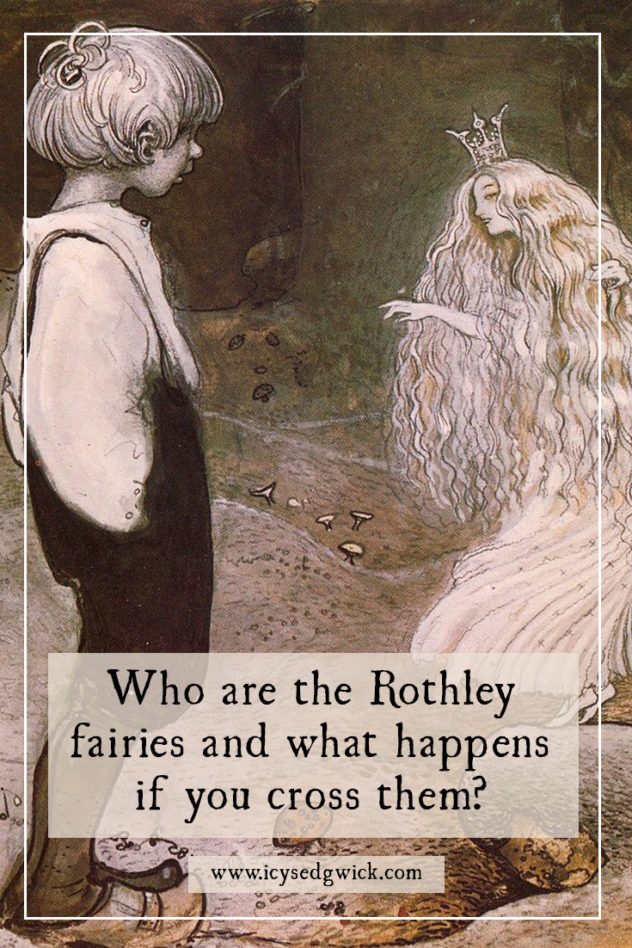Lots of places in Britain and Ireland feature stories of fairies that contradict the stereotypical view of them as benevolent wish granters. In the cold and sometimes unforgiving north of England, they can be particularly vindictive. We’ve discussed Northumbrian fairies before, but this time we’re going to explore two tales of the Rothley fairies.
The village lies 2 miles north-east of Cambo and 6 miles west of Morpeth. It’s also known for this rather attractive 18th-century folly, Rothley Castle.

Incidentally, Rothley is around 14 miles from Brinkburn. Perhaps the Rothley fairies use Brinkburn’s fairy graveyard.
But let’s go and explore two local tales of their fairies and their human encounters. As always, hit play to hear the audio version of this post, or keep reading below!
The miller and the Rothley fairies
A miller lived just south of Rothley. He shared the mill house with a family of fairies. They did the housework in exchange for some of the miller’s grain.
Frederick Grice describes the fairies in Folk Tales of the North Country (1951);
“They were lovely to see, none bigger than daffodils, but beautifully formed, with long flaxen hair flowing over their shoulders. Their mantles were as green as the sycamore buds in March, and each rode on a dapper little horse, cream-coloured like a primrose, and beautifully harnessed. They had saddles, bridles, and reins, all neatly stitched and sewn, and from the harness hung little bells no bigger than a raindrop, and each chiming with a pretty sound.”
John Hodgson claims in his History of Northumberland that the family were none other than Queen Mab herself and her court. He also claims the family often bathed in the nearby river. Though I can’t see Mab lowering herself to do housework.
Anyway. The fairies cooked their porridge in the kiln the miller used to dry his grain. Occasionally, they would stir the fire to give more heat to the porridge and the grain would burn. The miller understandably found this annoying as he couldn’t sell the ruined grain.
But by and large, the arrangement was a happy one.

Until a second fairy family moved in.
The fairies still finished the housework but they took twice as much grain. And they burned twice as much grain in the kiln.
The miller grew impatient with this change in affairs. One night, he found the grain burning in the kiln again. He lost his temper and threw a clod of earth into the fire.
Hot cinders and porridge spattered the hungry fairies waiting near the pot.
The cry went up; “Burnt and scalded!”
The miller realised his mistake and turned to run. One of the fairies caught up with him and grabbed his ankle. The miller fainted.
When he woke up, the Rothley fairies were gone. His entire leg was now paralysed and he never regained its use.
As we’ll see from our next story, fairies and cinders just do not mix!
The Little Boy and the Cinder
Elsewhere in the area, another small family risked the wrath of the Rothley fairies – but this time survived. M.A. Richardson relates this tale in his Table Book (1846: 48-49).
A widow and her young son lived in a cottage near the village. One night, the child refused to go to bed. The tired mother gave up and told him the fairies would come for him if he stayed up by himself.
Bear in mind, this is a time when people fervently believed in changelings or the fairies doing ill by them.
The widow went up to bed and the boy stayed downstairs. Soon after, a doll-like figure came down the chimney. Her friendly manner disarmed the boy and he overcame his fright. Perhaps lonely or looking for friends his own age, he asked her what her name was.
“Ainsel,” she replied. “And you?”
“My ainsel,” said the boy with a smirk. We can only assume that he was at the age when echoing people was the height of comedy.

They stayed up playing together until the fire began to die down. The boy fetched the poker and stirred the cinders. A scattering of hot ash fell out of the grate and onto Ainsel’s foot.
She roared in pain and the boy fled in terror. He’d barely hidden in bed when the door flew open downstairs.
“Who’s done this?” cried the fairy’s furious mother.
“My ainsel!” wept the fairy. My own self!
The mother’s wrath subsided.
“Well, you can only blame yourself then!”
She kicked her daughter up the chimney. I’m sure the young boy breathed a sigh of relief that his verbal trick paid off! The story doesn’t expand on whether they spent any more time together after that, but it’s unlikely.
So if you encounter the fairies, treat them with respect.
Many folk tales and legends explore the darker side of the fairy folk. I’ve written about Northumbrian fairies before, in the tale of the midwife and the fairies. But it’s perhaps helpful to look at a couple of stories from elsewhere in the British Isles to understand the reaction of these fairies.
In one old tale, which you can read here, a family didn’t let a fairy woman into their house. As a punishment for the slight, the eldest son temporarily lost his sight. Everywhere they went, the family took bad luck with them.
In another tale, called ‘Paddy Corcoran’s Wife’, a woman called Kitty threw wash water out of her house. Unfortunately, the fairy folk passed by at the same time and ended up covered in the water. She ended up sick for seven years with an illness no doctor could cure.

Eventually, one of the fairy folk turned up and explained to her why she was ill. The fairy woman told Kitty to throw out the wash water from a different door, and at a different time of day. Kitty did as she was asked and the next day she regained her full health.
Slighting, or annoying, the fairies carries some fairly heavy penalties!
Being respectful is a way to try and avoid their wrath. Bear in mind, these stories date to a time when being charitable and helpful to your neighbours was expected as the normal behaviour of a Christian. Spreading tales of the bad consequences should you slight a fairy could make people think twice about turning away someone in need.
Granted, the miller and the boy both knew the fairies were real. The boy injures the fairy by accident, the miller threw temper. But only a quirk of language saves the boy from a fate like that of the miller.
It’s safe to say that working with your fairy neighbours is probably the best way to stay on their good side…
If you enjoyed this post, sign up below and get new folklore posts straight in your inbox!
References
Richardson, M.A. (1846), The local historian’s table book, of remarkable occurrences, historical facts, traditions, legendary and descriptive ballads [&c.] connected with the counties of Newcastle-upon-Tyne, Northumberland and Durham. Legendary division, Volume 3, London: J.R. Smith (aff link).
Nutty about folklore and want more?
Add your email below and get these posts in your inbox every week.
You'll also get my 5-step guide to protecting your home using folklore!








I LOVE the “my Ainsel” story—it’s typical of a certain kind of story that warns people (and other creatures) to be wary of tricksters of all kinds.
I just love the reaction of the fairy’s mother!
Me too!
And there’s a Welsh tale where the family throw the wash water out on a fairy village – Why Dermott’s Front Door is in the Back. A short title!